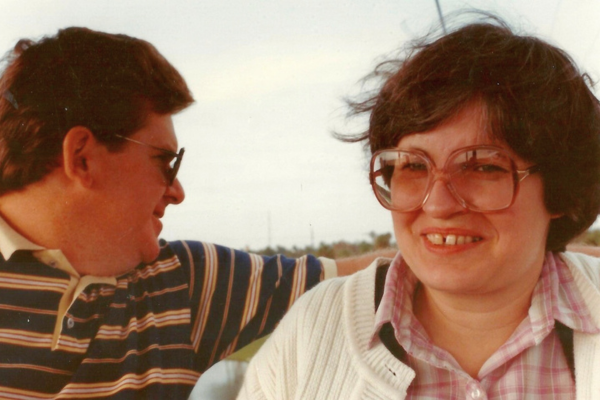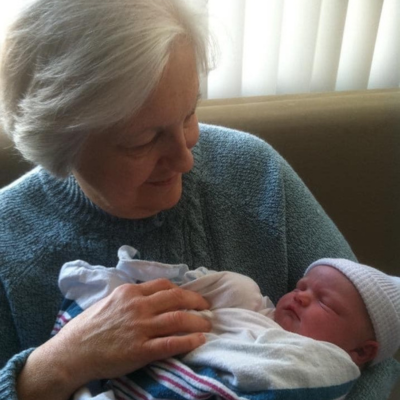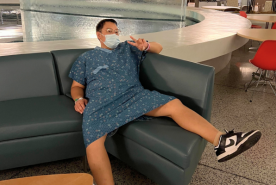October 09, 2025
To honor his mom’s memory, Tom joined NKF to produce exercise videos that help people with kidney disease, on dialysis, or post-transplant stay active and healthy.
Tom Whalen was shocked when he learned his mom had kidney failure and needed dialysis. Patricia (Pat) had lived with kidney disease for years without telling him or his sister.
In 2019, seven years after starting dialysis, she passed away. Today, Tom is honoring her memory by sharing their story, spreading awareness, and volunteering his time to make life a little easier for people with kidney disease.
A Sudden Diagnosis
Tom was in his early twenties when Pat first revealed she had polycystic kidney disease (PKD).
“My sister and I were at home. She just walked into the room and announced she had kidney disease and was starting dialysis,” Tom said. “We had no idea she had been sick for years.”
Like many from her generation, Pat kept her health struggles private, shielding her family from the hardest parts of her journey.
“She never wanted to upset us,” Tom shared. “She was selfless, always putting everyone but herself first.”
Understanding PKD
Until then, Tom and his sister had never heard about PKD or how it could affect their family.
“PKD is a genetic disorder that causes cysts to grow inside the kidneys,” Tom said. “Over time, these cysts can damage the kidneys, making it hard to filter waste and regulate fluids.
Knowing this prompted Tom and his sister to get checked for it.
“My sister does have PKD, but caught it early and is managing it well,” said Tom. “My aunt also developed kidney failure from PKD and received a transplant.”
Tom still gets regular ultrasounds to check his kidneys, determined not to be caught off guard the way he was with his mom’s diagnosis.
“We were blindsided once. I don’t want it to happen again to anyone in my family or to others reading this,” Tom said. “That’s why it is so important to know your family’s health history and talk about it openly.”
Life on Dialysis
Pat began in-center dialysis shortly after telling her children about her diagnosis.
“She treated it like a job, attending three times a week,” Tom said. “She never complained.”
But after five years, Pat grew tired of traveling to the dialysis center.
“She switched to home hemodialysis,” said Tom. “It gave her a bit of her life back."
Shortly after switching modalities, Pat was offered a high KDPI kidney. She turned it down.
“I didn’t understand at the time,” Tom said. “Looking back, I think she just wanted to spend the rest of her time in comfort, surrounded by family. She didn’t want to take the chance that it would only extend her life a few extra months.”
KDPI stands for Kidney Donor Profile Index. It is an estimate of how well a donated kidney may work. The higher the KDPI, the less time a kidney is expected to function.
Subscribe today!
Join the NKF Blog Newsletter
Get inspirational stories and kidney disease resources delivered to your inbox every month. You'll gain practical insights and expert advice to help you better understand and manage your kidney health, no matter where you are on your kidney journey.
Finding Peace at the Shore
With almost seven years of dialysis under Pat’s belt, Tom’s family banded together to give her a special gift.
“She always loved the shore, but hardly went,” Tom said. “We arranged a five-month beach rental for her and Dad to enjoy.”
In early January 2019, two months after moving into the rental, Pat passed away peacefully in a place she loved.
“It was hard,” Tom said. “But we were happy she at least got that experience. She deserved it.”
Grieving and Growing
Pat’s death left Tom grieving and lost.
“I lost my best friend,” he said. “I was running my video business, and helping my family emotionally and financially. Those first few months were a lot to handle.”
Therapy became his lifeline.
“Therapy gave me tools to move forward and support my dad, who lost his wife,” Tom said. “My parents’ generation didn’t really believe in therapy, but I think it’s so important.”
Alongside therapy, Tom found guidance and support through organizations like the National Kidney Foundation (NKF).
“NKF and other organizations like them can make a huge difference,” he said. “Whether that’s through education, financial help, or just knowing you’re not alone.”
NKF is here to support you on your kidney journey:
- NKF PEERs: Get one-on-one support from a trained peer mentor.
- NKF’s Online Communities: Anonymously ask questions and get answers on our secure online forum.
- NKF Cares: Call or message a trained NKF professional for help finding tools and resources.
Giving Back
Today, Tom is honoring his mom by giving back through a video production company he founded more than 15 years ago.
“We film sporting events, highlight reels, and showcases,” he explained. “But we wanted to use our skills in a way that helps people with kidney disease.”
Pegasus Sports Video partnered with NKF to do just that! They collaborated with Quintin Stinney (@quin.mov) and Omar Stinney (@omarstinney) to create a series of exercise videos tailored for people with kidney disease, those on dialysis, and post-transplant patients.
“It felt right to connect our work with something so meaningful,” Tom said. “It’s a way to honor my mom and support families going through what ours went through.”
By helping patients stay active safely, Tom hopes to make people’s journeys a little easier while also carrying Pat’s legacy forward.
“Be comfortable with the uncomfortable. That’s my motto now,” Tom said. “It’s what pushes me to grow, to give back, and to make a difference.”



















